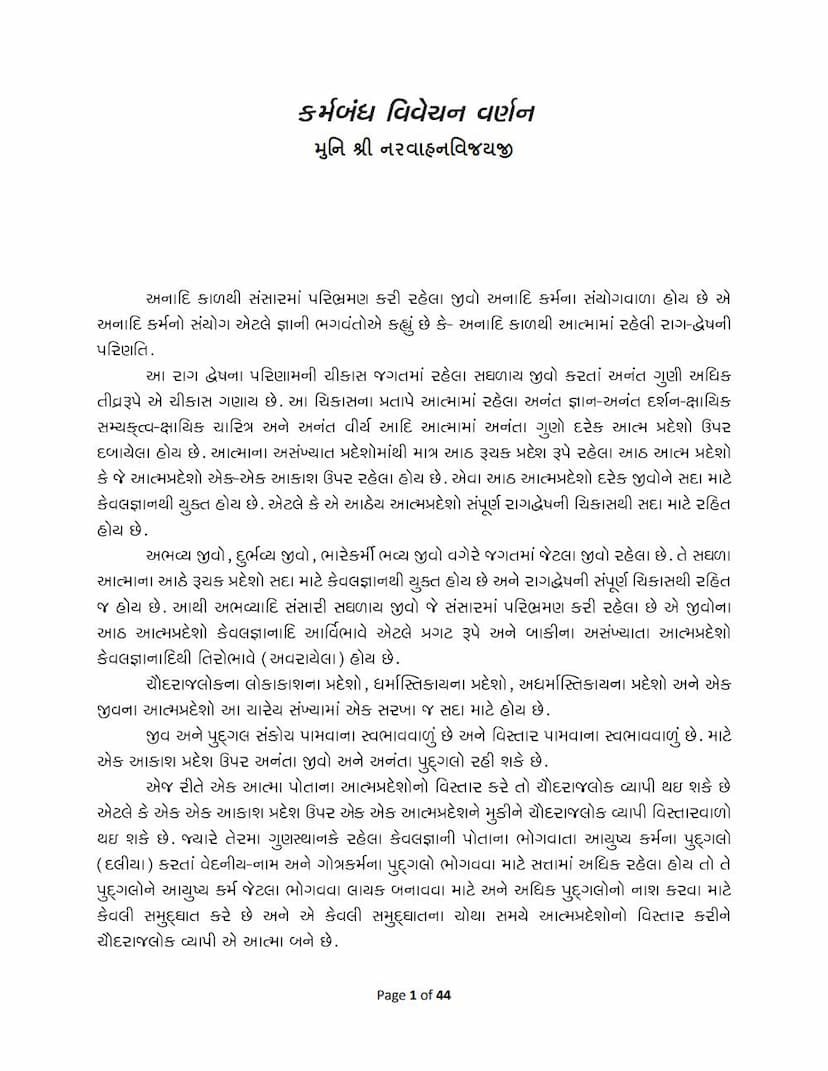Karm Bandha Vivechan Varnan
Added to library: September 2, 2025

Summary
This document is a summary and explanation of the Jain concept of Karma Bandha (bonding of karma), as detailed in the book "Karm Bandha Vivechan Varnan" by Muni Shri Narvahanvijayji.
Here's a breakdown of the key concepts discussed:
The Nature of the Soul and Karma:
- Innate Bondage: Souls are bound by karma from an anadi (beginningless) time. This bondage is caused by raag (attachment) and dwesh (aversion) inherent in the soul.
- Suppressed Qualities: This attachment and aversion cover the soul's infinite qualities, such as infinite knowledge, perception, conduct, and power. Only eight specific soul-regions (ruchak pradesh) remain unaffected by this bondage and are inherently pure. Even beings in lower states of existence possess these pure regions.
- Karmic Matter: Karma is composed of pudgals (subtle particles) that adhere to the soul due to its passions. These karmic particles cover and suppress the soul's natural qualities.
The Four Substances and their Subtlety:
The text elaborates on the relative subtlety of four substances:
- Kaal (Time): Considered grossest. The text describes the extreme subtlety of time, where countless moments pass within the time it takes a spear to pass through one lotus petal to the next.
- Kshetra (Space): More subtle than time. The vastness of the fourteen rajlokas (cosmic realms) is compared to a single angul (finger's width) of space filled with innumerable aakash pradesh (space points).
- Dravya (Matter/Substance): More subtle than space. An angul of space contains innumerable aakash pradesh, each of which can hold infinite pudgals.
- Bhav (Mental/Spiritual State): The subtlest. This refers to the soul's raag-dwesh tendencies, which cause the absorption of karmic pudgals and their transformation into specific karmas.
The Eight Karmas and their Functions:
The text details how the soul's passions (raag-dwesh) interact with karmic pudgals to form the eight types of karma, each affecting a specific soul quality:
- Gyanavarniya (Knowledge-obscuring): Obscures infinite knowledge.
- Darshanavarniya (Perception-obscuring): Obscures infinite perception.
- Vedniya (Feeling): Causes feelings of pleasure and pain.
- Mohaniya (Delusion): Causes confusion and delusion, obscuring right conduct.
- Namkarma (Name/Body-determining): Determines the soul's physical form and characteristics.
- Gotrakarma (Status/Lineage): Determines one's social standing or lineage.
- Antaraya (Obstruction): Obstructs the soul's inherent power and abilities.
- Ayushyakarma (Lifespan): Determines the duration of one's life.
The Process of Karma Formation:
- Attachment and Aversion: The soul's attachment (raag) and aversion (dwesh) are the primary drivers for attracting karmic pudgals.
- Binding: These passions transform the attracted pudgals into karma, which then adhere to the soul like milk mixing with water.
- Self-Creation: The soul itself, through its purusharth (self-effort and intention), creates karma. Karma is not an independent entity but a consequence of the soul's internal states.
Types of Souls and their Karma:
- Avyavahar Rashi (Unmanifested category): Souls in this category have relatively uniform passions.
- Vyavahar Rashi (Manifested category): Souls in this category have more varied experiences.
- Ekendriya (One-sensed beings): Even these basic beings engage in karma through their interactions with their environment, driven by pleasure and displeasure. The text explains how the consumption of even inert substances (which were once living) leads to karmic bondage.
The Role of Mind, Speech, and Body:
- Yoga: The combination of mind, speech, and body movements (yoga) is the mechanism through which the soul interacts with karmic matter.
- Mithyatva, Avirati, Kashaya, Yoga: These four factors (false belief, non-restraint, passions, and yoga) are identified as the primary causes for karmic bondage.
Detailed Breakdown of Karma Types and Their Manifestations:
The text delves into the specifics of how each karma is formed and how its subtle aspects (like intensity of passion, duration, and the distribution of karmic matter) play out. It discusses:
- Division of Karmic Matter: How a mass of karmic pudgals is divided into different karmas and then further into their various sub-types.
- Rasa Bandha (Bonding of Taste/Intensity): The intensity of the karmic "juice" or effect is determined by the intensity of the soul's passions. This is categorized into four levels of intensity (four-fold, three-fold, two-fold, and one-fold).
- Sthiti Bandha (Bonding of Duration): The duration for which karma remains bonded to the soul is also determined by the soul's state and passions.
- Nikaachit Karma: Certain karmic bonds can become so firmly ingrained that they are very difficult or impossible to alter (nikachit).
- Deshghati and Sarvghati: Karmas can be sarvghati (completely obstructing a quality) or deshghati (partially obstructing).
The Path to Liberation:
The text emphasizes the importance of:
- Understanding the Nature of Karma: Comprehending how karma operates is the first step.
- Controlling Passions: Minimizing attachment (raag) and aversion (dwesh) is crucial.
- Developing Right Faith (Samyaktva): Cultivating true understanding of reality and the soul's nature.
- Practicing Restraint (Virati) and Austerity (Tapa): Engaging in virtuous actions and disciplines.
- Nirjara (Shedding of Karma): Actively working to shed accumulated karma through various means.
- Samyak Darshan, Samyak Gyan, Samyak Charitra: The path to liberation involves right perception, right knowledge, and right conduct.
- Vairagya (Detachment): Developing a sense of detachment from worldly pleasures and a yearning for the soul's innate bliss.
- Moksha Abhilasha (Desire for Liberation): Cultivating a genuine aspiration for liberation from the cycle of birth and death.
The text provides extensive details about the specific karmas, their subdivisions, and the conditions under which they are bound, along with the resulting experiences. It highlights the graded nature of karmic effects and the crucial role of the soul's intentions and efforts in determining its karmic destiny. The ultimate goal is to purify the soul by shedding all karma and achieving liberation.